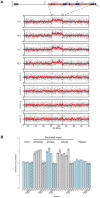OTX2 duplication is implicated in hemifacial microsomia
- PMID: 24816892
- PMCID: PMC4016008
- DOI: 10.1371/journal.pone.0096788
OTX2 duplication is implicated in hemifacial microsomia
Abstract
Hemifacial microsomia (HFM) is the second most common facial anomaly after cleft lip and palate. The phenotype is highly variable and most cases are sporadic. We investigated the disorder in a large pedigree with five affected individuals spanning eight meioses. Whole-exome sequencing results indicated the absence of a pathogenic coding point mutation. A genome-wide survey of segmental variations identified a 1.3 Mb duplication of chromosome 14q22.3 in all affected individuals that was absent in more than 1000 chromosomes of ethnically matched controls. The duplication was absent in seven additional sporadic HFM cases, which is consistent with the known heterogeneity of the disorder. To find the critical gene in the duplicated region, we analyzed signatures of human craniofacial disease networks, mouse expression data, and predictions of dosage sensitivity. All of these approaches implicated OTX2 as the most likely causal gene. Moreover, OTX2 is a known oncogenic driver in medulloblastoma, a condition that was diagnosed in the proband during the course of the study. Our findings suggest a role for OTX2 dosage sensitivity in human craniofacial development and raise the possibility of a shared etiology between a subtype of hemifacial microsomia and medulloblastoma.
Conflict of interest statement
Figures



Similar articles
-
14q22.3 duplication including OTX2 in a girl with medulloblastoma: A case report with literature review.Am J Med Genet A. 2024 Jul;194(7):e63604. doi: 10.1002/ajmg.a.63604. Epub 2024 Mar 21. Am J Med Genet A. 2024. PMID: 38511879 Review.
-
Autosomal dominant oculoauriculovertebral spectrum and 14q23.1 microduplication.Am J Med Genet A. 2013 Aug;161A(8):2030-5. doi: 10.1002/ajmg.a.36007. Epub 2013 Jun 21. Am J Med Genet A. 2013. PMID: 23794319
-
OTX2 duplications: a recurrent cause of oculo-auriculo-vertebral spectrum.J Med Genet. 2023 Jun;60(6):620-626. doi: 10.1136/jmg-2022-108678. Epub 2022 Nov 11. J Med Genet. 2023. PMID: 36368868
-
Branchiootorenal syndrome and oculoauriculovertebral spectrum features associated with duplication of SIX1, SIX6, and OTX2 resulting from a complex chromosomal rearrangement.Am J Med Genet A. 2008 Oct 1;146A(19):2480-9. doi: 10.1002/ajmg.a.32398. Am J Med Genet A. 2008. PMID: 18666230
-
Etiology and Pathogenesis of Hemifacial Microsomia.J Dent Res. 2018 Nov;97(12):1297-1305. doi: 10.1177/0022034518795609. Epub 2018 Sep 11. J Dent Res. 2018. PMID: 30205013 Review.
Cited by
-
Transcriptome analyses of murine right and left maxilla-mandibular complex.Orthod Craniofac Res. 2023 Dec;26 Suppl 1(Suppl 1):39-47. doi: 10.1111/ocr.12660. Epub 2023 Apr 18. Orthod Craniofac Res. 2023. PMID: 37073503 Free PMC article.
-
Nasal DNA methylation differentiates corticosteroid treatment response in pediatric asthma: A pilot study.PLoS One. 2017 Oct 13;12(10):e0186150. doi: 10.1371/journal.pone.0186150. eCollection 2017. PLoS One. 2017. PMID: 29028809 Free PMC article.
-
Familial Oculoauriculovertebral Spectrum: A Genomic Investigation of Autosomal Dominant Inheritance.Cleft Palate Craniofac J. 2025 Jan 17:10556656241306202. doi: 10.1177/10556656241306202. Online ahead of print. Cleft Palate Craniofac J. 2025. PMID: 39819101 Free PMC article.
-
SPECC1L regulates palate development downstream of IRF6.Hum Mol Genet. 2020 Mar 27;29(5):845-858. doi: 10.1093/hmg/ddaa002. Hum Mol Genet. 2020. PMID: 31943082 Free PMC article.
-
Genomic associations with bill length and disease reveal drift and selection across island bird populations.Evol Lett. 2018 Jan 26;2(1):22-36. doi: 10.1002/evl3.38. eCollection 2018 Feb. Evol Lett. 2018. PMID: 30283662 Free PMC article.
References
-
- Gorlin RJ CM, Hennekam RCM (2001) Syndromes of the head and neck. New York: Oxford University Press.
-
- Heike CL, Hing AV (2009) Craniofacial Microsomia Overview. In: Pagon RA, Adam MP, Bird TD, Dolan CR, Fong CT, et al..., editors. GeneReviews. Seattle (WA).
-
- Rimoin DL EA (2006) Emery and Rimoin's principles and practice of medical genetics. Philadelphia: Churchill Livingstone.
-
- Poswillo D (1988) The aetiology and pathogenesis of craniofacial deformity. Development 103 Suppl 207–212. - PubMed
-
- Werler MM, Sheehan JE, Hayes C, Padwa BL, Mitchell AA, et al. (2004) Demographic and reproductive factors associated with hemifacial microsomia. Cleft Palate Craniofac J 41: 494–450. - PubMed
Publication types
MeSH terms
Substances
LinkOut - more resources
Full Text Sources
Other Literature Sources
Miscellaneous

